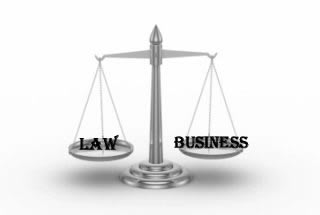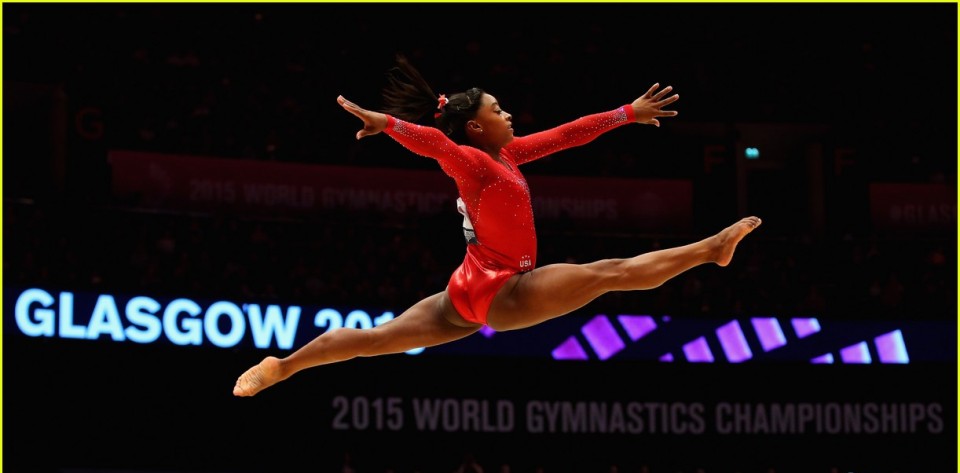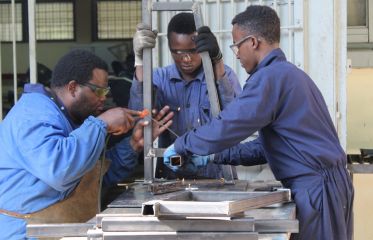Fans of the Summer Olympics can't seem to get enough of American gymnast Simone Biles. The 19-year-old, who has already snagged gold medals in events for the team, individual all-round and vault competitions, can jump, flip and twist in ways the average person likely never will. Biles may make it look easy, but between all the different events that gymnasts have to master — from balance beam to the vault for women, and the pommel horse to the rings for men physics is at the core of every apparatus. Below are some physics applications in gymnastics
1. Vault
Vault is an explosive event where a gymnast run with full speed, reach the apparatus and spring off in it a graceful but powerful combination of flips and twists.

Gymnasts on the vault
 Torque is a common technique used when the gymnast is in the air.
Torque is a common technique used when the gymnast is in the air.
Torque is a measure of how much a force acting on an object causes that object to rotate.
It is defined as T=|r|*|F|*sin, which is the cross product of vector r and F. In the vault event, gymnasts must use torque to get the appropriate speed of rotation.
During the gymnastic events, gymnasts are seen to be sprinting to the apparatus. There is a physics law behind it the name of Newtons Second Law of Mortion. For them to generate the required force to execute the routine, they need acceleration and their mass

Gymnast accelerating to the vault in Olympics 2012 in London
APPLIED FORCE = OBJECT'S MASS* OBJECTS ACCELERATION
NEWTON'S SECOND LAW OF MOTION
2. Uneven Bars
Uneven bars is the event solely for female gymnasts. Gymnasts need to transfer between the bars and to perform gracefully as well as powerfully.


Gymnast on the even bars during the 2012 Olympic in London Illustration of the Centripetal force
During transferring, gymnasts will revolve around the bar for several times to accelerate so that they can break the centrifuge force. They will use the linear velocity to fly to the next bar and revolve to re-create centrifuge force
FOR EVERY ACTION THERE IS AN EQUAL AND OPPOSITE DIRECTION
NEWTON'S THIRD LAW OF MOTION
 When the gymnast reaches the top (handstand position), the gravity forces her to fall down.
When the gymnast reaches the top (handstand position), the gravity forces her to fall down.
During this period, the gymnast applies a downward force on the bar.
According to Newton's third law of motion, the bar will offer an equal and opposite force on the gymnast.
This upward force enables the gymnast to go up again.
3. Beam Balance
Balance beam is the event performed by female gymnasts only. It requires gymnasts to keep balance on the beam and to perform artistically.

Gymnast on the beam balance
Gymnasts are able to jump up and fall down on the beam stably mainly because of the static friction, which prevents tended motion. Static friction can be defined as f= μN
Friction plays an important role in balance beam. The beam used nowadays are covered with rubber or leather to increase the friction coefficient to prevent the gymnasts from slipping off the equipment. Gymnasts also apply french chalk on their hands to cause the same effect.
MOVING OBJECTS WILL NOT SPONTANEOUSLY SPEED UP, SLOW DOWN OR CHANGE DIRECTION.
NEWTON'S FIRST LAW OF MOTION

Gymnast somersaulting
Newton's first law of motion is widely applied in the backhand spring of beam. Gymnasts will first run at full speed to get sufficient kinetic energy, helping themselves to finish the spring. Since the left kinetic energy gymnasts gain remains with them, they typically try to land with their knees bent. In this way, the absorption of energy can be smoothly met.































